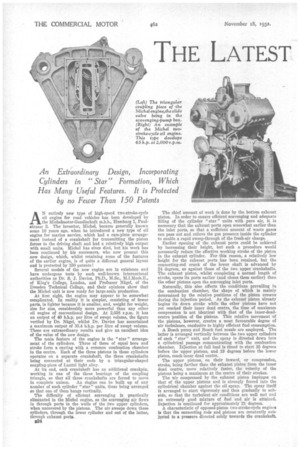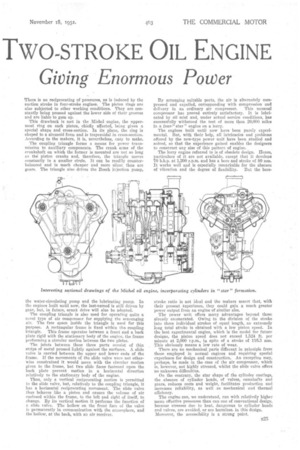THE LATEST TWO-STROKE OIL ENGINE
Page 50

Page 51

If you've noticed an error in this article please click here to report it so we can fix it.
Giving Enormous Power
An Extraordinary Design, Incorporating Cylinders in "Star Formation, Which Has Many Useful Features. It is Protected by no Fewer Than 150 Patents
AN entirely new type of high-speed two-stroke-cycle oil engine for road vehicles has been developed by the Michelmotor-Gesellschaft m.b.h., Hamburg 1, Paulstresse 2. The inventor, Michel, became generally known some 10 years ago, when he introduced a new type of oil engine for marine service, which had a cam-plate arrangement instead of a crankshaft for transmitting the piston forces to the driving shaft and had a relatively high output with small units. Michel has since died, but his work has been continued by his successors, who now present this new design, which, whilst retaining some of the features of the earlier engine, is of quite a different general layout and is protected by 150 patents!
Several models of the new engine are in existence and have undergone tests by such well-known international authorities as Dr. S. S. Davies, Ph.D., M.Sc., M.I.Mech.E., of King's College, London, and Professor Nagel, of the Dresden Technical College, and their opinions show that the Michel unit is now ready for large-scale production.
At first sight, the engine may appear to be somewhat complicated. In reality it is simpler, consisting of fewer parts, is lighter because it is smaller, and, weight for weight, size for size, considerably more powerful than any other oil engine of conventional design. At 2,058 r.p.m. it has an output of 40 b.h.p. per litre of swept volume, the figure verified by Dr. Nagel, whilst Dr. Davies has ascertained a maximum output of 35.4 b.h.p. per litre of swept volume. These are extraordinary results and give an excellent idea of the value of the new design.
The main feature of the engine is the "star" arrangement of the cylinders. Three of these of equal bore and stroke form a casting with a common combustion chamber in the centre. Each of the three pistons in these cylinders operates on a separate crankshaft, the three crankshafts being connected at their ends by a triangular-shaped coupling-piece of Lautal light alloy.
At its end, each crankshaft has an additional crankpin, working in one of the three bearings of the coupling triangle, so that all three 'crankshafts are forced to move in complete unison. An engine can be built up of any number of such cylinder "star" units, these being arranged so that one of them hangs vertically.
The difficulty of efficient scavenging is practically eliminated in the Michel engine, as the scavenging air flows in through ports in the walls of the two upper cylinders, when uncovered by the pistons. The air sweeps down these cylinders, through the lower cylinder and out of the latter, through exhaust ports. The chief amount of work is done by the bottom exhaust piston. In order to ensure efficient scavenging and adequate filling of the cylinder " star " units with pure air, it is necessary that the exhaust ports open somewhat earlier than the inlet ports, so that a sufficient amount of waste gases can pass out and relieve the gas pressure inside the cylinder to enable a rapid sweep-through of the fresh-air charge.
Earlier opening of the exhaust ports could be achieved by increasing their height, but such a procedure would necessarily reduce the effective working stroke of the piston in the exhaust cylinder. For this reason, a relatively low height for the exhaust ports has been retained, but the connecting-rod crank of the lower shaft is advanced by 24 degrees, as against those of the two upper crankshafts. The exhaust piston, whilst completing a normal length of stroke opens its ports earlier (and closes them earlier) than the other pistons open the scavenging inlet ports.
Naturally, this also affects the conditions prevailing in the combustion chamber, the shape of which is mainly determined by the relative positions of the piston crowns during the injection period. As the exhaust piston already begins its down stroke while the other pistons have not yet reached their inner dead centre, the time of maximum compression is not identical with that of the inner-deadcentre position of the pistons. This relative movement of the pistons, however, creates a most favourable degree of air turbulence, conducive to highly efficient fuel consumption.
A Bosch pump and Bosch fuel nozzle are employed. The latter is arranged vertically between lie two upper cylinders of each "star" unit, and the spray is directed down into a cylindrical passage communicating with the combustion chamber. rtfjection at full load is timed to start 35 degrees before the upper pistons, and 19 degrees before the lower piston, reach inner dead centre.
The upper pistons on their inward, or compression, stroke, being farther than the exhaust piston from the inner dead centre, move relatively faster, the velocity of the pistons being a maximum at the centre of their strokes. The 'air compressed by the exhaust piston impinges on that of the upper pistons and is strongly forced into the cylindrical chamber against the oil spray. The spray itself is arranged to start vigorously and then gradually to subside, so that the turbulent air conditions are well met and an extremely good mixture of fuel and air is attained. Injection is continued for approximately 21 degrees.
A characteristic of opposed-piston two-stroke-cycle engines Is that the connecting rods and pistons are constantly subjected to a pressure directed solely towards the crankshaft. There is no reciprocating of pressures, as is induced by the suction stroke in four-stroke engines. The piston rings are also subjected to other working conditions, They are constantly being pressed against the lower side of their grooves and are liable to gum up.
This drawback is met in the Michel engine, the uppermost ring on each piston, chiefly affected, being given a special shape and cross-section. In its plane, the ring is shaped to a sinusoid form and is trapezoidal in cross-section. According to the makers, it is, nevertheless, easy to make.
The coupling triangle forms a means for power transmission to auxiliary components. The crank arms of the crankshaft on which the former is mounted are not so long as the piston cranks and, therefore, the triangle moves constantly in a smaller circle. It can be readily counterbalanced and is muc.h cheaper and more silent than are gears. The triangle also drives the Bosch injection pump, the water-circulating pump and the lubricating pump. In the engines built until now, the last-named is still driven by gear, but, in future, crank drive will also be adopted.
The coupling triangle is also used for operating quite a novel type of air compressor for supplying the scavenging air. The free space inside the triangle is used for this purpose. A rectangular frame is fixed within tha coupling triangle. This frame operates between a front and a back plate rigid with the stationary body of the engine, the frame performing a circular motion between the two plates.
The joints between these three parts consist of thin strips of metal pressed lightly against the surfaces. A slide valve is carried between the upper and lower ends of the frame. If the movements of the slide valve were not otherwise constrained it would move with the circular motion given to the frame, but two slide faces fastened upon the back plate prevent motion in a horizontal direction relatively to the stationary body of the engine.
Thus, only a vertical reciprocating motion is permitted to the slide valve, hut, relatively to the coupling triangle, it has a horizontal reciprocating movement. The slide valve thus behaves like a piston and causes the volume of air enclosed within the frame, to the left and right of itself, to change. By its vertical motion it performs the function of a slide valve. The hollow on the front face of the valve is permanently in communication with the atmosphere, and the 'hollow, at the back, with an air receiver. By arranging suitable ports, the air is alternately compressed and expelled, corresponding with compression and delivery in an ordinary air compressor. This unusual cornPressor has proved entirely satisfactory. It is lubricated by oil mist and, under actual service conditions, has successfully withstood the test of more than 20,000 miles in a four-" star" engine on a lorry.
The engines built until now have been purely experimental. But, with their help, all intricacies and problems offered by the new-type power unit have been studied and solved, so that the experience gained enables the designers to construct any size of this pattern of engine.
The lorry engine referred to is of obsolete design. Hence, particulars of it are not available, except that it develops 70 b.h.p. at 1,200 r.p.m. and has a bore and stroke of 80 mm. It works well and is especially remarkable for the absence of vibration and the degree of flexibility. But the bore stroke ratio is not ideal and the makers assert that, with their present bxperienee, they could gain a much greater power output from an engine of similar size.
The power unit offers many advantages beyond those already enumerated. Owing to the division of the stroke into three individual strokes of equal length, an extremely long total stroke is obtained with a low piston speed. In the best experimental engine, which is the model for future designs, the piston speed does not exceed 1,524 ft. per minute at 2,000 r.p.m., in spite of a stroke of 116.3 mm. This obviously means a low rate of wear.
There are DO mechanical parts different in principle from these employed in normal engines and requiring special experience for design and construction. An exception may, perhaps, be made in the case of the air compressor, which is, however, not highly stressed, whilst the slide valve offer no unknown difficulties.
On the contrary, the star shape of the cylinder castings, the absence of cylinder heads, of valves, camshafts and gears, reduces 'costs and weight, facilitates production and increases reliability, as well as mechanical and thermal efficiency.
The engine can, we understand, run with relatively higher mean effective pressures than can one of conventional design, because stresses due to heat, dangerous to cylinder heads and valves, are avoided, or are harmless, in this design. Moreover, the accessibility is a strong point.




















































































































